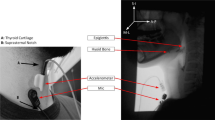Abstract
We previously used cervical auscultation (CA) to describe the stability of swallow-associated sounds of infant feeding. To date, no similar studies have been performed in adults. The objectives of this study were to identify the initial discrete sounds (IDS) of adult swallows and compare the stability of IDS signals in infants to that of adults. We performed CA with a microphone and accelerometer fixed simultaneously to the neck of 20 healthy adults. Each participant consumed a liquid, puree, and solid. The microphone and accelerometer collected signals of similar duration. The variance index (VI), an assessment of the stability of the IDS, was compared in adults and a group of low-risk preterm infants. The VI of adults swallowing liquid (29.1 [24.1, 36.6] {25%, 75%}) did not differ from that of preterm infants older than 36 weeks PMA (36.3 [33.4, 41.9]), but was lower than the VI of infants younger than 36 weeks PMA (49.0 [46.4, 51.1]; p < 0.05). This is the first real-time comparison of microphones and accelerometers for CA. The stability of IDS of low-risk preterm infants approaches that of normal adults as the infants age. Because successful feeding in infants is often used as a surrogate for normal development, the stability of swallow-associated sounds deserves more investigation as a potential marker for neurologic well-being.




Similar content being viewed by others
References
Reynolds EW, Vice FL, Bosma JF, Gewolb IH. Cervical accelerometry in preterm infants. Dev Med Child Neurol 2002;44:587–92.
Reynolds EW, Vice FL, Gewolb IH. Cervical accelerometry in preterm infants with and without bronchopulmonary dsyplasia. Dev Med Child Neurol 2003;45:442–6.
Takahashi K, Groher ME, Michi K-I. Methodology for detecting swallowing sounds. Dysphagia 1994;9:54–62.
Bulow M, Olsson R, Ekberg O. Videoradiographic analysis of how carbonated thin liquids and thickened liquids affect the physiology of swallowing in subjects with aspiration on thin liquids. Acta Radiol 2003;44(4):366–72.
Zenner PM, Losinski DS, Mills RH. Using cervical auscultation in the clinical dysphagia examination in long-term care. Dysphagia 1995;10:27–31.
Lefton-Greif MA, Loughlin GM. Specialized studies in pediatric dysphagia. Semin Speech Lang 1996;17:311–29.
Soentgen ML, Pierce HS, Brenman HS. Mouthing activities in the human neonatal sucking act. Arch Oral Biol 1969;14:1159–67.
Burke PM. Swallowing and the organization of sucking in the human newborn. Child Dev 1977;48:523–31.
Truby HM, Lind J. Cry sounds of newborn infants. Acta Pediatr Scand 1965;163(Suppl):7–60.
Bosma JF, Truby HM, Lind J. Cry motions of the newborn infant. Acta Pediatr Scand 1966;163(Suppl):61–92.
Bosma JF, Truby HM, Lind J. Studies of neonatal transition: correlated cineradiographic and visual-acoustic observations. Acta Pediatr Scand 1966;163(Suppl):93–109.
Bosma JF, Truby HM, Lind J. Distortion of upper respiratory and swallow motions in infants having anomalies of the upper pharynx. Acta Pediatr Scand 1966;163(Suppl):111–28.
Vice FL, Heinz JM, Giuriati G, Hood M, Bosma JF. Cervical auscultation of suckle feeding in newborn infants. Dev Med Child Neurol 1990;32:760–8.
Vice FL, Bamford O, Heinz JM, Bosma JF. Correlation of cervical auscultation with physiological recording during suckle-feeding in newborn infants. Dev Med Child Neurol 1995;37:167–79.
Cichero JAY, Murdoch BE. Detection of swallowing sounds: methodology revisited. Dysphagia 2002;17:40–9.
Leslie P, Drinnan MJ, Zammit-Maempel I, Coyle JL, Ford GA, Wilson JA. Cervical auscultation synchronized with images from endoscopy swallow evaluations. Dysphagia 2007;22:290–8.
Robbins J, Hamilton JW, Lof GL, Kempster GB. Oropharyngeal swallowing in normal adults of different ages. Gastroenterology 1992;103:823–9.
Gewolb IH, Vice FL, Schweitzer-Kenney EL, Taciak VL, Bosma JF. Developmental patterns of rhythmic suckle and swallow in preterm infants. Dev Med Child Neurol 2001;43:22–7.
Gewolb IH, Bosma JF, Taciak VL, Vice FL. Abnormal developmental patterns of suck and swallow rhythms during feeding in preterm infants with bronchopulmonary dysplasia. Dev Med Child Neurol 2001;43:454–9.
Gewolb IH, Bosma JF, Reynolds EW, Vice FL. Integration of suck and swallow rhythms during feeding in preterm infants with and without bronchopulmonary dysplasia. Dev Med Child Neurol 2003;45:344–8.
Author information
Authors and Affiliations
Corresponding author
Rights and permissions
About this article
Cite this article
Reynolds, E.W., Vice, F.L. & Gewolb, I.H. Variability of Swallow-associated Sounds in Adults and Infants. Dysphagia 24, 13–19 (2009). https://doi.org/10.1007/s00455-008-9160-5
Received:
Accepted:
Published:
Issue Date:
DOI: https://doi.org/10.1007/s00455-008-9160-5




